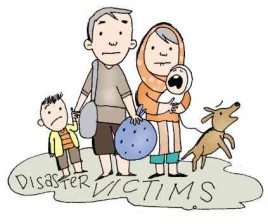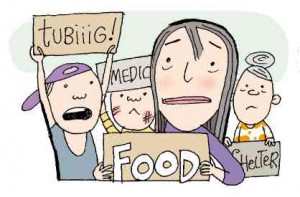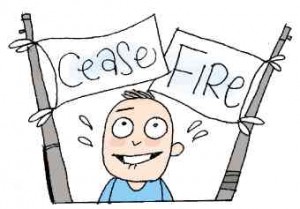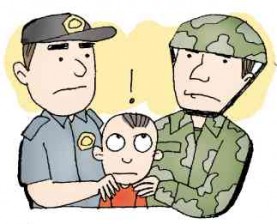Yolanda’s complex emergency
 Last year I wrote about the destructive impact of Typhoon “Pablo” and the lessons we learned from that disaster (Inquirer, Dec. 22, 2012).
Last year I wrote about the destructive impact of Typhoon “Pablo” and the lessons we learned from that disaster (Inquirer, Dec. 22, 2012).
Two weeks ago it was déjà vu of the worst kind after we saw similar images of destruction and the tragic loss of life after the onslaught of Supertyphoon “Yolanda” (international name: “Haiyan”). What have we failed to learn from Tropical Storms “Ondoy” and “Sendong,” and Pablo that caused us to suffer immensely and react so poorly in the case of Yolanda?
Because of the typhoon’s awesome strength and wide reach, and the deadly effects of its violent storm surge—local, national and international responses to Yolanda will most likely stand as the benchmark of disaster response and risk management (DRRM) strategies in the country and the rest of the world for some time.
Let it not be a lesson of what not to do. It is therefore important to learn from this tragedy—assessing the responsiveness, or the lack of it, of different state and nonstate actors before, during and after the onslaught of the typhoon.
Complaints about the lack of sufficient food, water and shelter, and the government’s poor response to the disaster is commonplace in every crisis of this magnitude. This is partly due to trauma and to weak quick-response capacity.
Most of all, it represents the failure to understand the dynamics of complex emergencies and a recurring blindness to the social and political underpinnings of this tragedy.

The crisis spawned by Yolanda is a complex emergency—a natural disaster with social and political signifiers—that worsens or mitigates the impact of a calamity.
Scholars of emergencies and disasters have often pointed to the inextricable sociopolitical dimensions and institutions that humanitarian aid workers need to navigate to ensure that problems of fragility and vulnerability do not lead to violent conflict and crime.
In short, complex emergencies rarely follow the relief-rehabilitation-development continuum and will require zigzags along the way. A strong understanding of the social and political context should enable the use of strategies and approaches that can mitigate the ill effects of fragility and conflict.
If supplies cannot reach the victims, bring the victims to the supplies.
Among the key social institutions that frame people’s responses to disaster is the aversion to being uprooted from their land. In Yolanda’s case, the ferocity of the typhoon destroyed any sense of social risk among the victims who were willing to abandon their houses, livelihoods and farms, and move out of their villages and towns.
It was clear from the outset that the dangers of starvation and disease had overwhelmed the social aversion to being uprooted from their communities.
Yet days after the typhoon left its trail of destruction, victims who were trying desperately to get out of Tacloban were met by relief agencies equally desperate to get in. Humanitarian aid workers in conflict areas are often involved in the creation of escape routes from the theater of conflict or disaster.
Part of their task is to establish safe zones where relief operations can be undertaken. This should have happened soon after the scale of destruction emerged. However, facilitating the exodus of refugees to resettlement sites near the areas of massive destruction was not organized in a systematic manner.
Instead, the refugees themselves established these self-settlement areas in places such as Catbalogan, Ormoc, Cebu and Pasay City.

Camps have been known to dislocate the economic strategies of poor people, creating more dependency and, in some cases, extending their trauma. Long-term relief and rehabilitation need to harness people’s own survival strategies to allow them to restore dignity and bring back order into their lives at the soonest.
Setting up refugee camps have often been criticized for primarily serving the agenda of states and international aid agencies that wish to restore order and to control refugee populations to facilitate the provision of relief. Yet studies have shown that camps can be breeding grounds for disease and sites of violence themselves.
In Zamboanga, the refugee camp bred respiratory diseases and measles. Meanwhile, after the 2008 conflict flashpoint in northern Mindanao refugee numbers dwindled to a handful of families who sought shelter in refugee camps. This was because refugee camps became sites of rido or clan feuding. Approaches that are grounded on and buttressed by local knowledge and cultural sensitivities will allow a more effective and relevant response.
Informal economies as vital lifelines

However, informal economies are double-edged. They can trigger community-level conflict in the case of looting, or become a vital lifeline by providing precious goods and services in times of crisis—albeit at a higher price.
A more realistic approach in the case of Leyte and Samar requires a nuanced strategy that can allow continued access to supplies and services that people desperately need with the government shouldering the higher costs during the interim, especially in the case of transport.
Government incentives should have allowed all sorts of vessels, registered or unregistered, to ply the Matnog-Allen route, and the Cebu-Ormoc and Cebu-Tacloban route immediately after the disaster. The government could have also prevented private vehicles from using up vital space in roll-on, roll-off vessels and other ferries and ring-fenced these assets for the exclusive use of relief trucks or public buses.
Sensitivity to conflict risks
It is a well-known fact that a “live insurgency” exists in the major typhoon-affected areas of Eastern Visayas. Yet this element has received scarce media attention before, during and after the disaster.
People and communities living in the areas where the Communist Party of the Philippines-New People’s Army (CPP-NPA) operates were equally affected by the wrath of Yolanda. There is reason to believe that these areas will not receive assistance and support without proactive government intervention.
This means at least two things: one, that interventions should be conflict-sensitive, and two, that a window of opportunity to broker a cessation of hostilities or a ceasefire can be utilized to create better conditions for the safe transport and distribution of relief supplies to far-flung communities where rebels thrive.
In the case of Aceh, Indonesia, the 2003 tsunami produced the conditions that led to a final political settlement between the Gerakan Aceh Merdeka and the Republic of Indonesia.
It is clear that conflict sensitivity, or the lack of it has determined the government’s response to the disaster and predicted the real dangers that may follow.
For example, a firm grasp of the conflict’s dimension must determine whether the military or the civilian police and bureaucracy should take the lead in the policing and protection of victims in disaster-affected areas.
Stationing government troops in such close proximity to insurgent forces heightens the risk of armed confrontation. Worse, the deployment of multinational troops in a live conflict area also risks internationalizing the conflict.
A sound policy should be to deploy the Philippine National Police for policing and avoid deploying the Armed Forces of the Philippines for tasks outside reconstruction and emergency transport and evacuation.
The government should also ensure that the multinational response does not hamper the task of trained and professional humanitarian relief organizations.
Ceasefire or no ceasefire

A cessation of hostilities also ensures that communities influenced by insurgent groups will receive aid on time, with the people they trust or “proxies” facilitating the extension of humanitarian relief.
Critical is the bridging of government efforts such as those of the Department of Social Welfare and Development (DSWD) and the initiatives of neutral nongovernment organizations (NGOs) and civil society that can enter these areas. As in the case of Pablo a year ago, ensuring an inclusive approach also prevents aid recipients from being a target of predation by excluded groups and insurgents.
The CPP issued a ceasefire declaration to all concerned commands to take effect from Nov. 9 to 24, assuring “all local and international relief organizations of safe passage through and into the calamity-affected guerrilla zones.”
Local and national NGOs, such as International Alert UK and Mindanao Peace Weavers Inc., have issued similar calls.
International aid should be inclusive and conflict sensitive

Responding to climate and disaster-induced community-level and insurgency-related conflict will become a necessary capability and capacity that national government agencies, local governments and civil society organizations will need in the future.
Meanwhile, humanitarian organizations should not circumvent government and national structures because better coordination and leadership are critical for the sustainability of relief, recovery and rebuilding efforts.
Focus attention, resources on rescue and relief effort during most critical early moments

They divert attention and resources away from the rescue and relief effort and redirect it toward securing VIPs and their entourage. Site visits by high-ranking officials and their security contingents during these critical moments also compete for the precious passenger and cargo space available for transporting relief supplies and those who need urgent medical attention.
There is an appropriate time to visit a disaster zone and a time to stay away. All attention and resources of first responders and security officials should be focused solely on the victims and their families during the initial critical period following a calamity.
Decentralize national disaster response to the local level

However, more resources need to be deployed at the local level. It is also critical that local, village level institutions are harnessed during an emergency. Over the medium term, the National Disaster Risk Reduction and Management Council (NDRRMC) should strengthen its regional counterparts with resources, assets and funds for quick response and monitoring.
Discourse is critical

The experience teaches us that simple and accessible language is important and will spell the difference between action and inaction. Filipino sociologist Randy David admonishes us to communicate danger using language that is based on people’s social constructs.
The challenge is to rephrase disaster risk reduction and management strategies to make them familiar and accessible, and to push people to take appropriate preventive action.
In the end, one thing is at least certain—these typhoons and their destructive effects are now part of our collective experience and will surely shape our social constructs about danger and destruction, as well as our courage and humanity.
(Nikki de la Rosa is Mindanao operations manager of International Alert UK. She finished her masters in international development, with distinction, from the London School of Economics. She is the author of a related article titled “Cut and Paste Disaster Management,” published in Talk of the Town after Typhoon Pablo’s onslaught in Mindanao in 2012.)

















